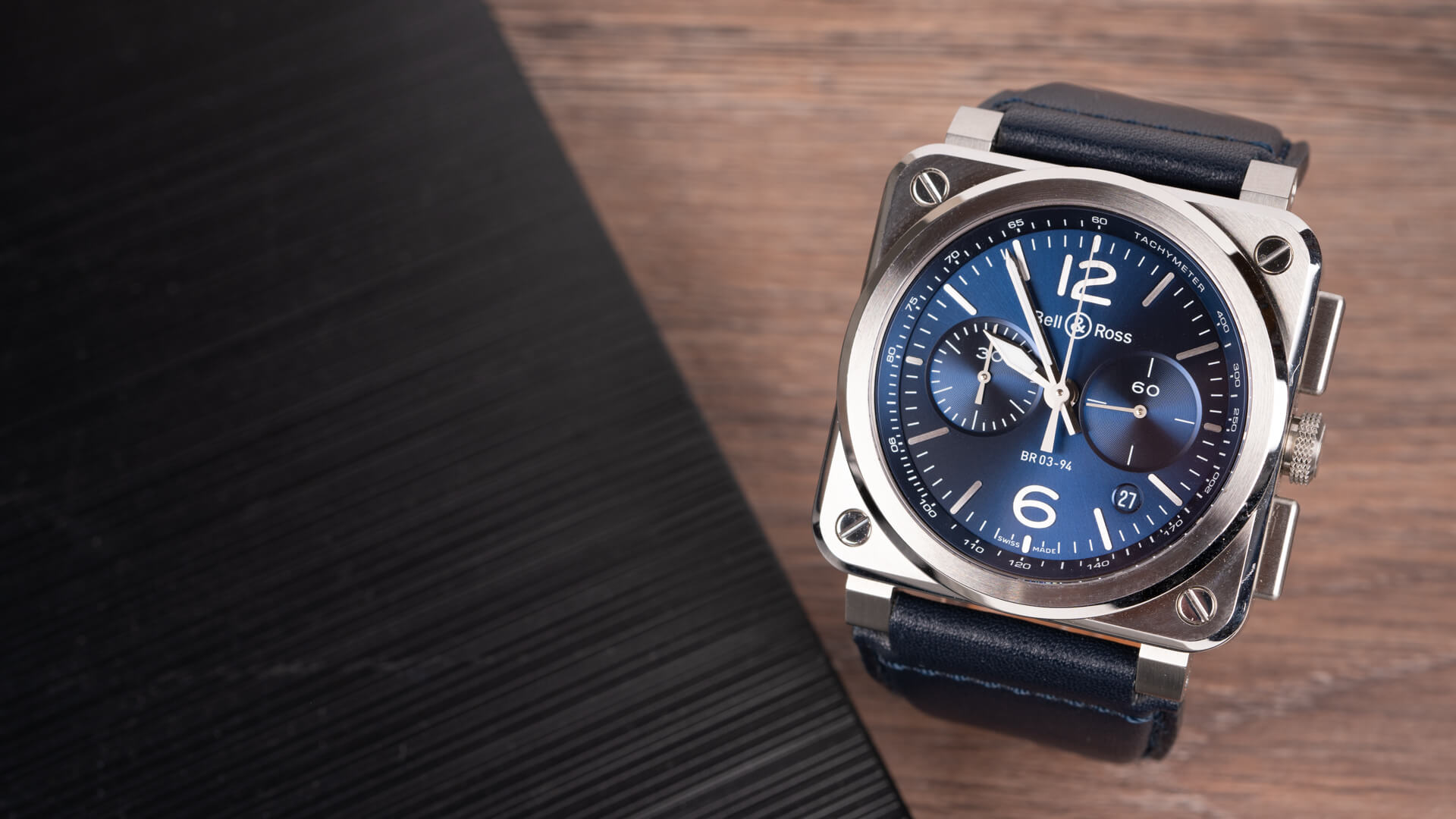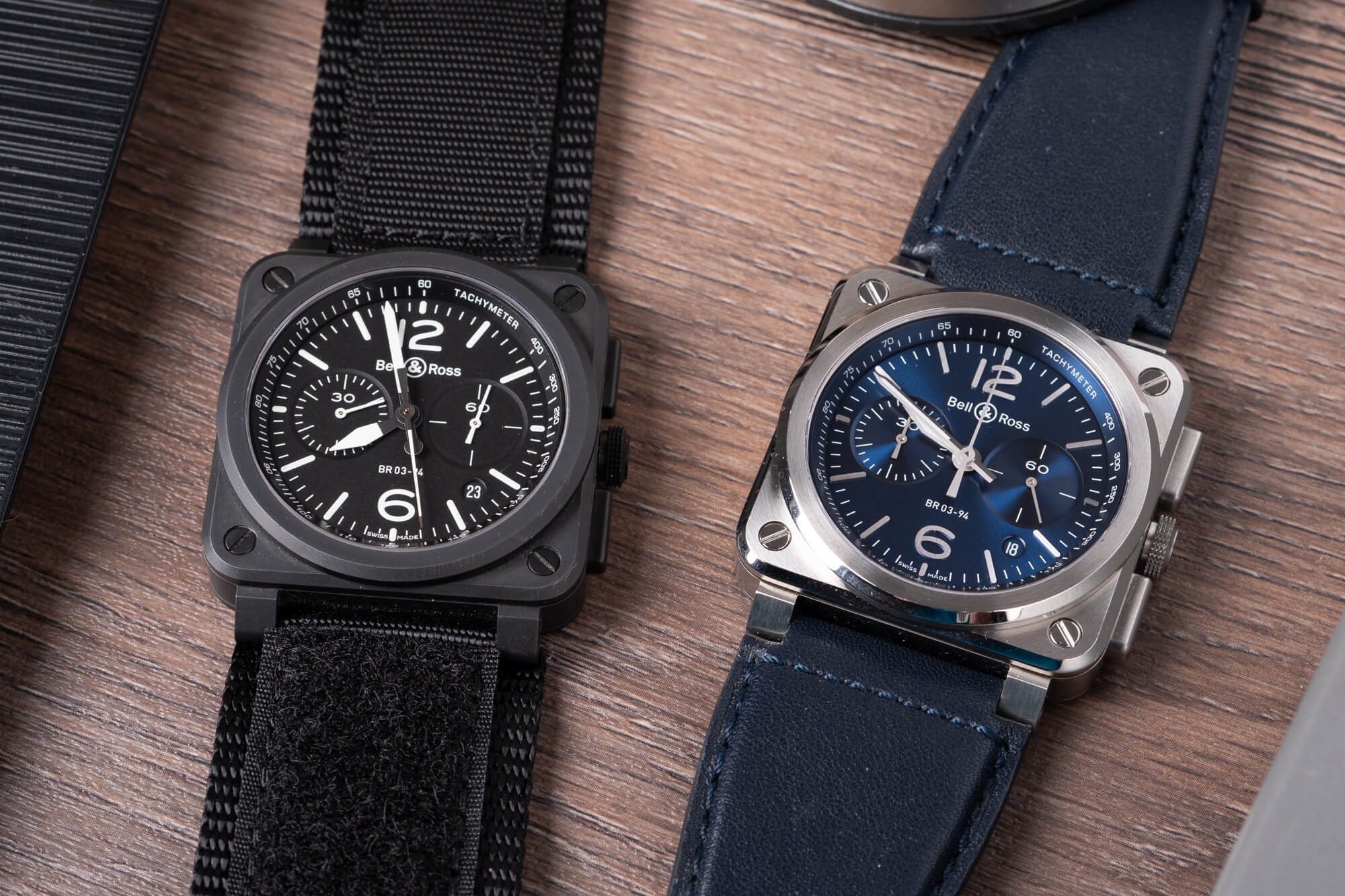 I’ll admit that when I first encountered the square watches of Bell & Ross, I was a skeptic, at best. I thought they were gimmicky and clunky and oversized and unwearable. Why would anyone want a square watch that’s otherwise the same? Why would you want more heft on your wrist? Obviously, I hadn’t actually tried one of the brand’s signature aviation instrument-inspired watches. When I finally got the chance to spend time with one (last year’s Radiocompass), I realized my folly: As so many of us do, I’d made a snap judgment based on cursory glances. When you actually get to experience Bell & Ross watches, you realize that their appeal extends well beyond the (not so) gimmicky case design. While offerings like the Radiocompass may be a bit too much for some, and the time-only models are sparse, the Bell & Ross BR 03-94 Chronograph might just be the brand’s Goldilocks model.
I’ll admit that when I first encountered the square watches of Bell & Ross, I was a skeptic, at best. I thought they were gimmicky and clunky and oversized and unwearable. Why would anyone want a square watch that’s otherwise the same? Why would you want more heft on your wrist? Obviously, I hadn’t actually tried one of the brand’s signature aviation instrument-inspired watches. When I finally got the chance to spend time with one (last year’s Radiocompass), I realized my folly: As so many of us do, I’d made a snap judgment based on cursory glances. When you actually get to experience Bell & Ross watches, you realize that their appeal extends well beyond the (not so) gimmicky case design. While offerings like the Radiocompass may be a bit too much for some, and the time-only models are sparse, the Bell & Ross BR 03-94 Chronograph might just be the brand’s Goldilocks model.
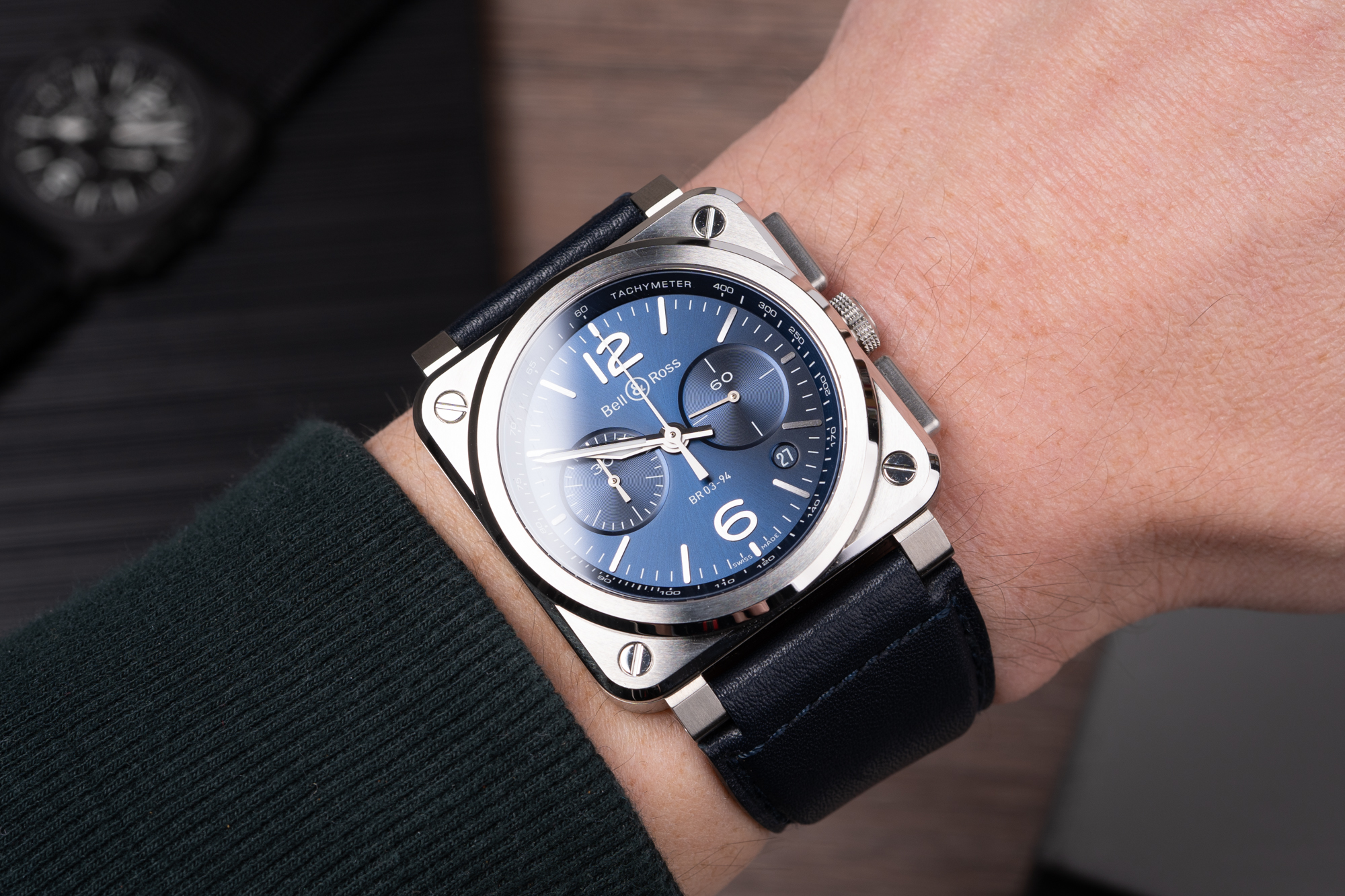 Let me get straight to the point, for those still doubting my wisdom. The undeniably blocky case of the BR 03-94 Chronograph wears far better than you’d think, but there’s a catch. The pleasurable wearing experience is entirely afforded by the straps that B&R pairs with the watches. The BR 03-94 is available with a rubber, leather, or Velcro strap, all three of which flare wide to meet the exterior edge of the lugs (having tried all three, I recommend opting for the rubber, as it’s easily the most comfortable). Whereas with a normal strap, the square case sits too prominently on the wrist, with the flared, wider straps, the entire package has the same presence as a wide cuff or bangle. Nothing stands out because it is made to look and feel more like a single piece encircling the wrist. That’s the magic of these Bell & Ross Instrument pieces, and given that the brand doesn’t offer any non-flared strap options, I have to assume it’s very intentional.
Let me get straight to the point, for those still doubting my wisdom. The undeniably blocky case of the BR 03-94 Chronograph wears far better than you’d think, but there’s a catch. The pleasurable wearing experience is entirely afforded by the straps that B&R pairs with the watches. The BR 03-94 is available with a rubber, leather, or Velcro strap, all three of which flare wide to meet the exterior edge of the lugs (having tried all three, I recommend opting for the rubber, as it’s easily the most comfortable). Whereas with a normal strap, the square case sits too prominently on the wrist, with the flared, wider straps, the entire package has the same presence as a wide cuff or bangle. Nothing stands out because it is made to look and feel more like a single piece encircling the wrist. That’s the magic of these Bell & Ross Instrument pieces, and given that the brand doesn’t offer any non-flared strap options, I have to assume it’s very intentional.
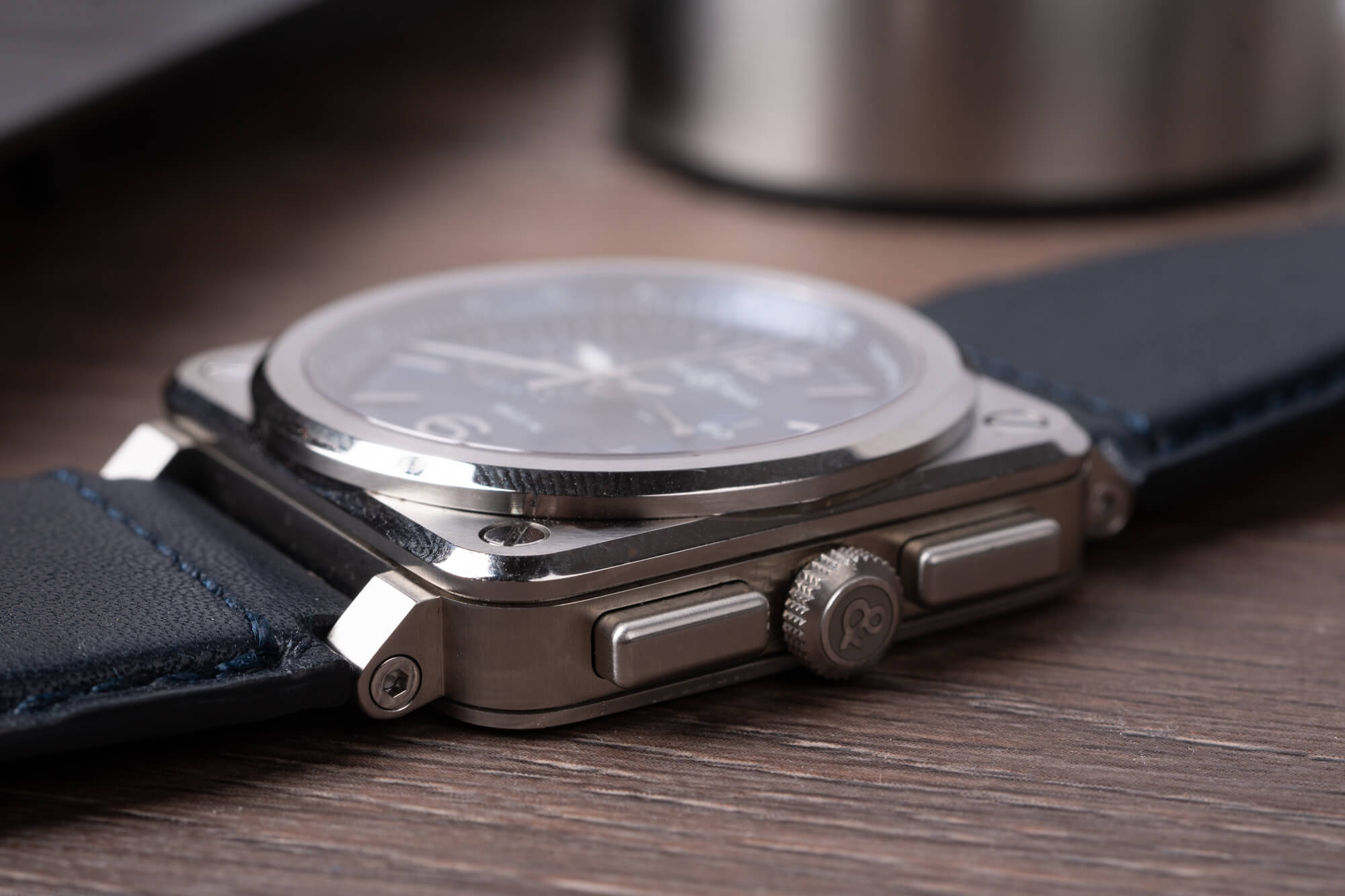
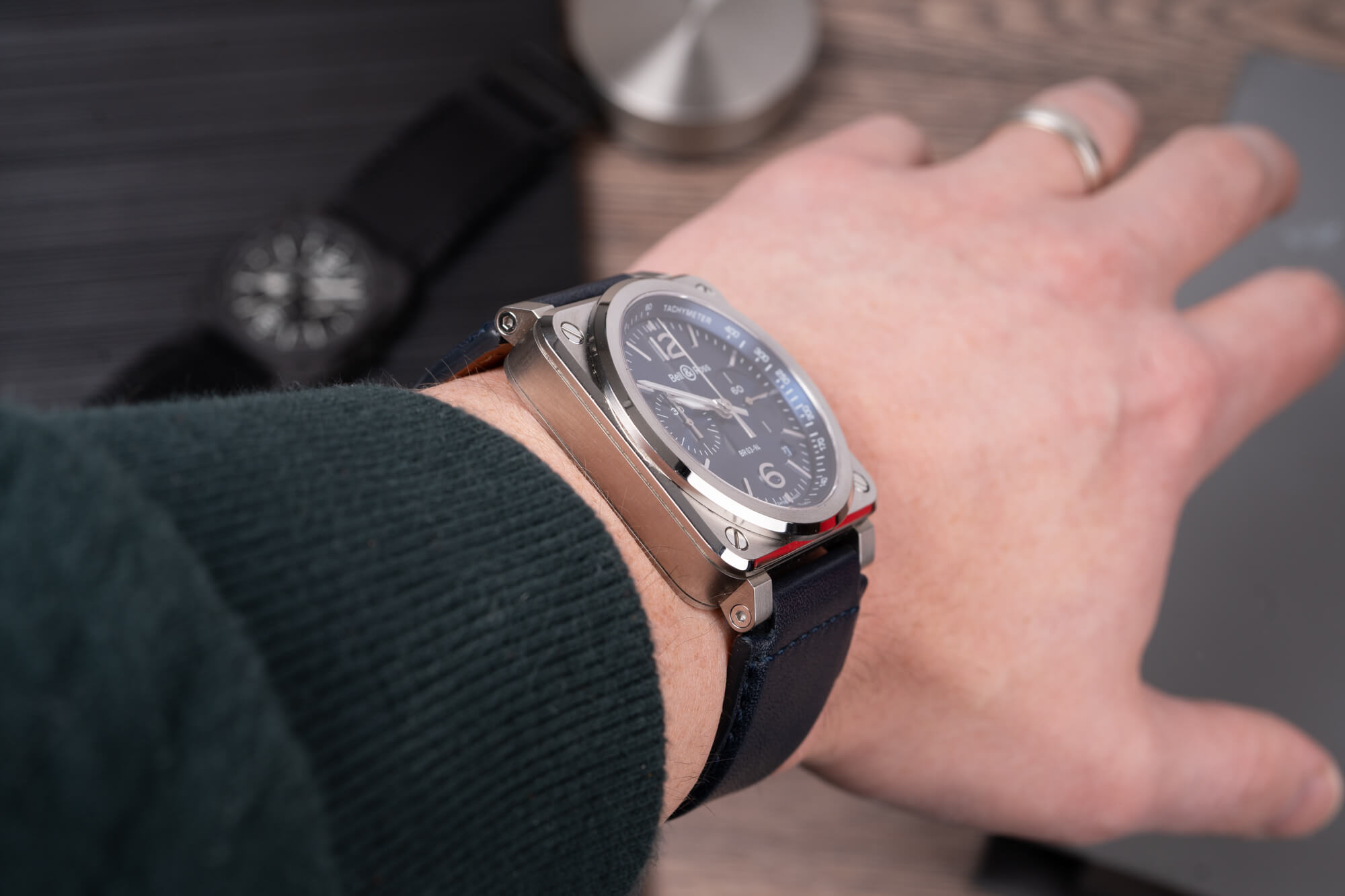 But what about that case? There are several versions of the BR 03-94, but only two case materials: steel and black ceramic (Bell & Ross used to use DLC coatings, but wised up and went full ceramic several years ago). The cases measure 42mm on each side and 12.8mm-tall, a rather impressive height for an automatic chronograph with 100m water resistance. The steel case is uniformly brushed aside from two polished beveled edges, while the ceramic case is entirely matte. The lugs are small and angled enough that their presence is almost negligible when considering the dimensions of the case (the lug-to-lug is 51.5mm); they only extend so far as to allow the straps to connect. The straps are attached with hex screws, which would be unfortunate if there were any reason at all to put it on a different strap (see above for discussion of flared straps). A sapphire crystal is flat and sits flush with the bezel, while bolts are aligned on the top and used to secure the caseback (similar to the Royal Oak). There are plenty of chronographs that phone in pusher design, creating a generic or disjointed look on otherwise attractive watches (or just making an ugly watch uglier). On the BR 03-94, though, the brand has taken the time to design rectangular pushers that fit perfectly with the rest of the case (flanking the pull-out crown), maintaining the case’s utilitarian modernity.
But what about that case? There are several versions of the BR 03-94, but only two case materials: steel and black ceramic (Bell & Ross used to use DLC coatings, but wised up and went full ceramic several years ago). The cases measure 42mm on each side and 12.8mm-tall, a rather impressive height for an automatic chronograph with 100m water resistance. The steel case is uniformly brushed aside from two polished beveled edges, while the ceramic case is entirely matte. The lugs are small and angled enough that their presence is almost negligible when considering the dimensions of the case (the lug-to-lug is 51.5mm); they only extend so far as to allow the straps to connect. The straps are attached with hex screws, which would be unfortunate if there were any reason at all to put it on a different strap (see above for discussion of flared straps). A sapphire crystal is flat and sits flush with the bezel, while bolts are aligned on the top and used to secure the caseback (similar to the Royal Oak). There are plenty of chronographs that phone in pusher design, creating a generic or disjointed look on otherwise attractive watches (or just making an ugly watch uglier). On the BR 03-94, though, the brand has taken the time to design rectangular pushers that fit perfectly with the rest of the case (flanking the pull-out crown), maintaining the case’s utilitarian modernity.
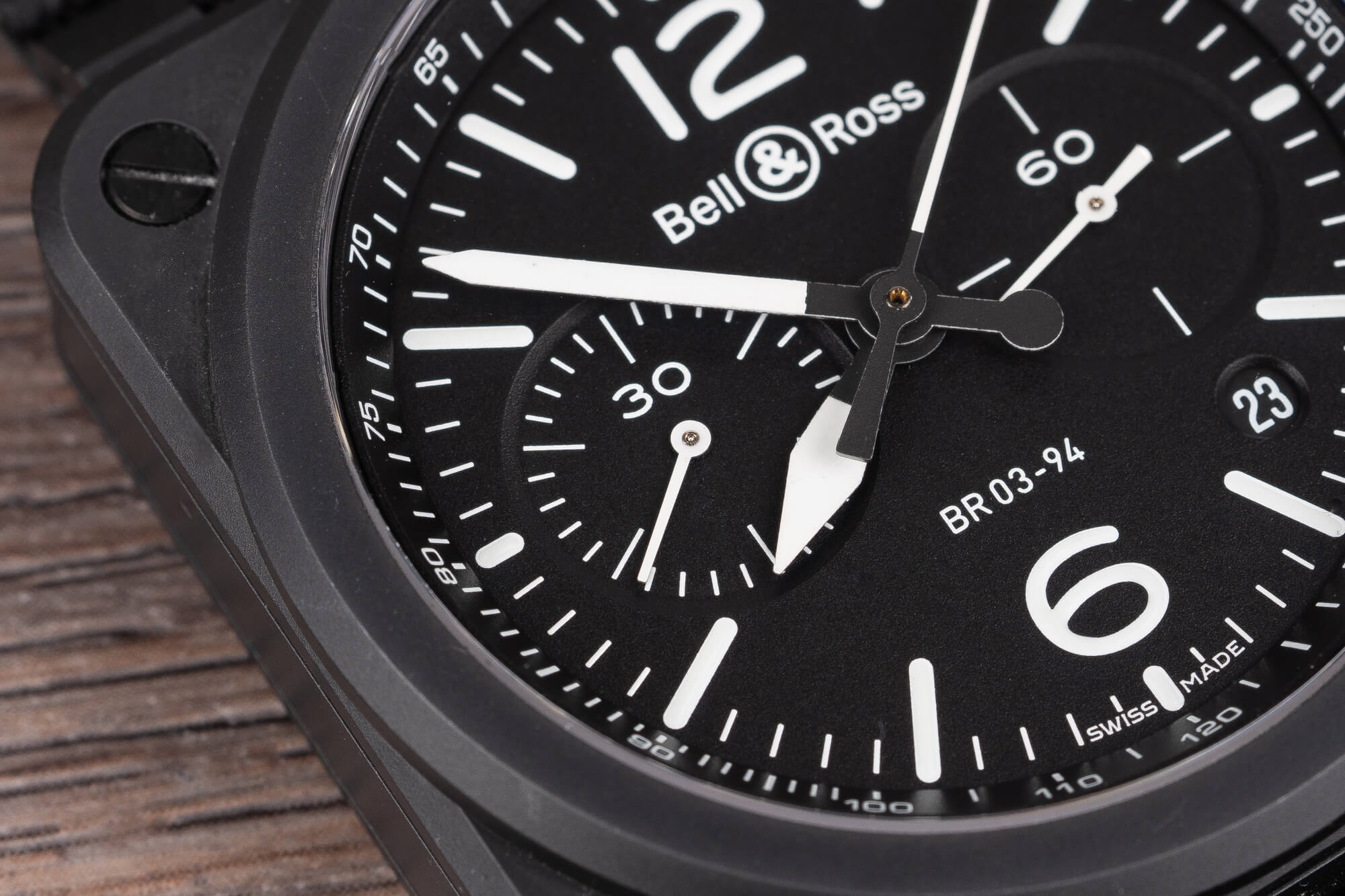
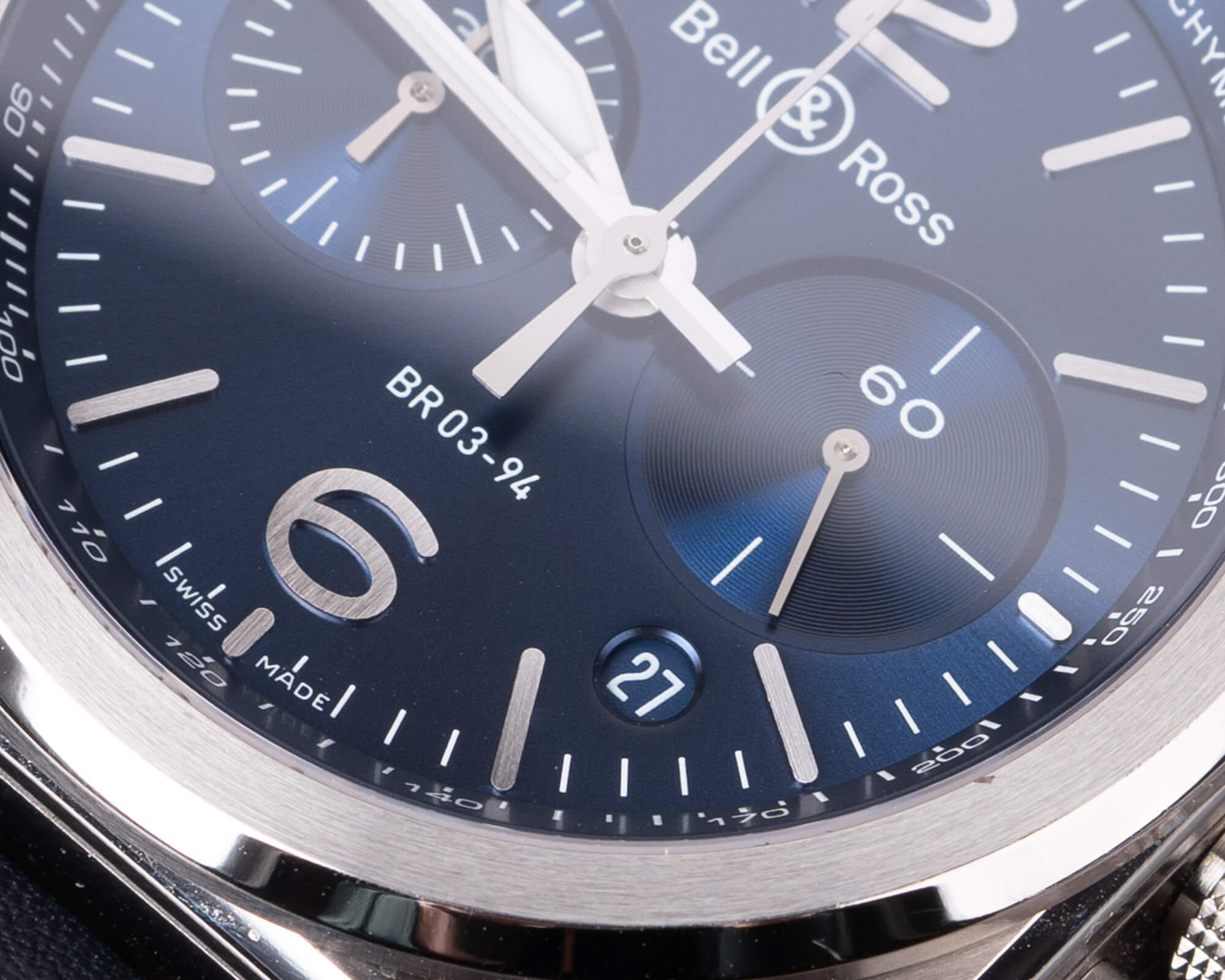 More often than not, different dial colors of the same watch do not have many differences aside from their color. That’s not quite the case here, though. In a way, the dials echo the styling of their respective cases. On the black ceramic, the matte black dial features printed lumed markings, flat white lumed hands, and no other texture. Like the matte black ceramic of the case, it is simple and functional, perhaps the purest interpretation of the cockpit dials from which it takes its inspiration. The steel case, though, features a radiant finish, applied brushed markers, and polished, beveled hands; this is a more refined display consistent with the more sophisticated appearance of the steel case. While neither watch has impressive lume, the lume on the blue dial is kept to the hour and minute hands. Both dials feature sunken subdials at 3 and 6 displaying running seconds and 30-min chrono minutes, respectively (again, the blue dial gets circular azurage finishing for its subdials). Similarly, both have the 12 and 6 numerals that have become recognizable on B&R watches. And, of course, they share a 4:30 date. While not ideal as far as date windows go, this is executed about as well as a 4:30 date can be. While the black dial certainly takes the cake for legibility, I never had any issues with the blue dial, as the steel hands and markers stand out against the vibrant blue background.
More often than not, different dial colors of the same watch do not have many differences aside from their color. That’s not quite the case here, though. In a way, the dials echo the styling of their respective cases. On the black ceramic, the matte black dial features printed lumed markings, flat white lumed hands, and no other texture. Like the matte black ceramic of the case, it is simple and functional, perhaps the purest interpretation of the cockpit dials from which it takes its inspiration. The steel case, though, features a radiant finish, applied brushed markers, and polished, beveled hands; this is a more refined display consistent with the more sophisticated appearance of the steel case. While neither watch has impressive lume, the lume on the blue dial is kept to the hour and minute hands. Both dials feature sunken subdials at 3 and 6 displaying running seconds and 30-min chrono minutes, respectively (again, the blue dial gets circular azurage finishing for its subdials). Similarly, both have the 12 and 6 numerals that have become recognizable on B&R watches. And, of course, they share a 4:30 date. While not ideal as far as date windows go, this is executed about as well as a 4:30 date can be. While the black dial certainly takes the cake for legibility, I never had any issues with the blue dial, as the steel hands and markers stand out against the vibrant blue background.
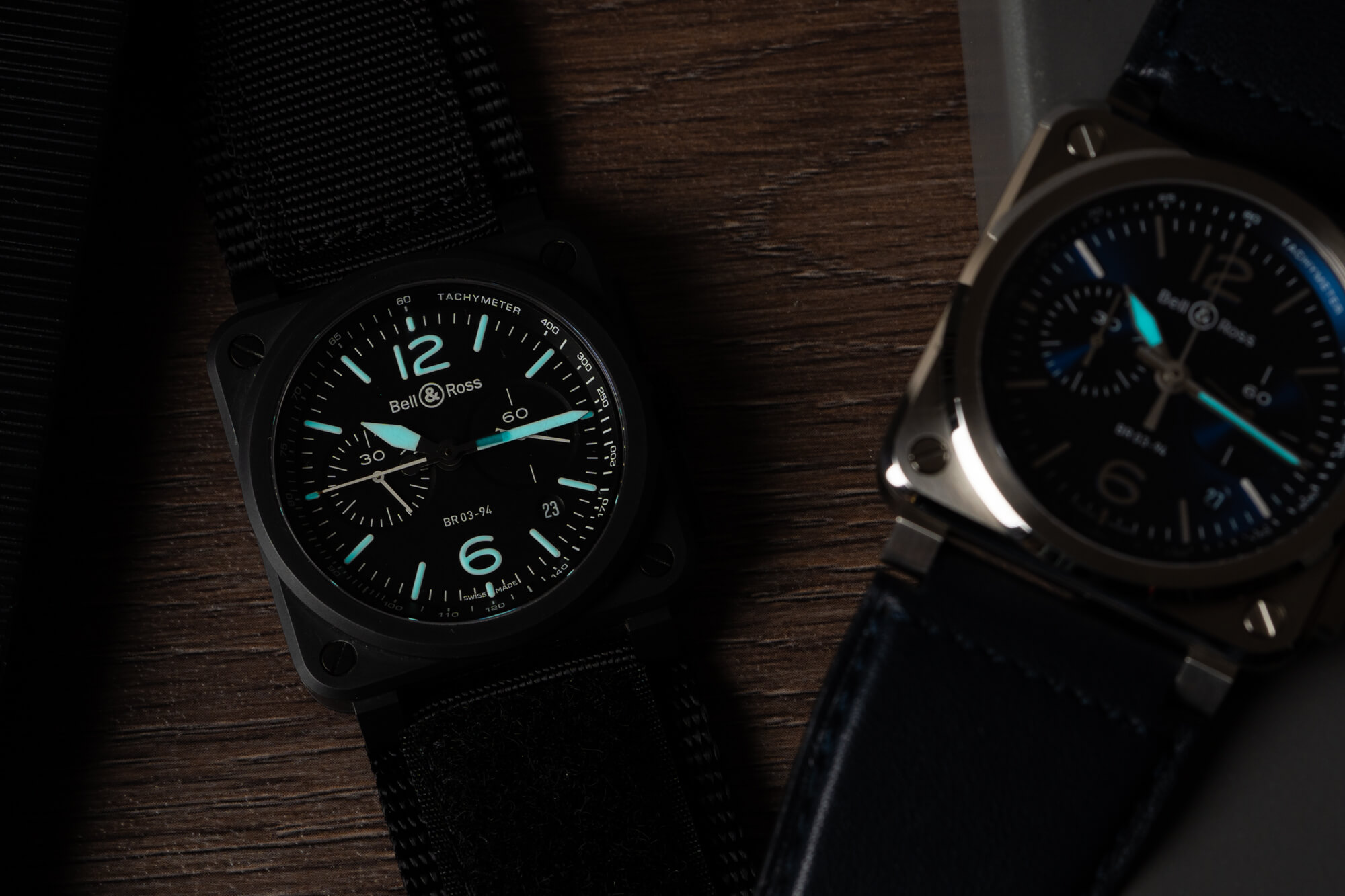
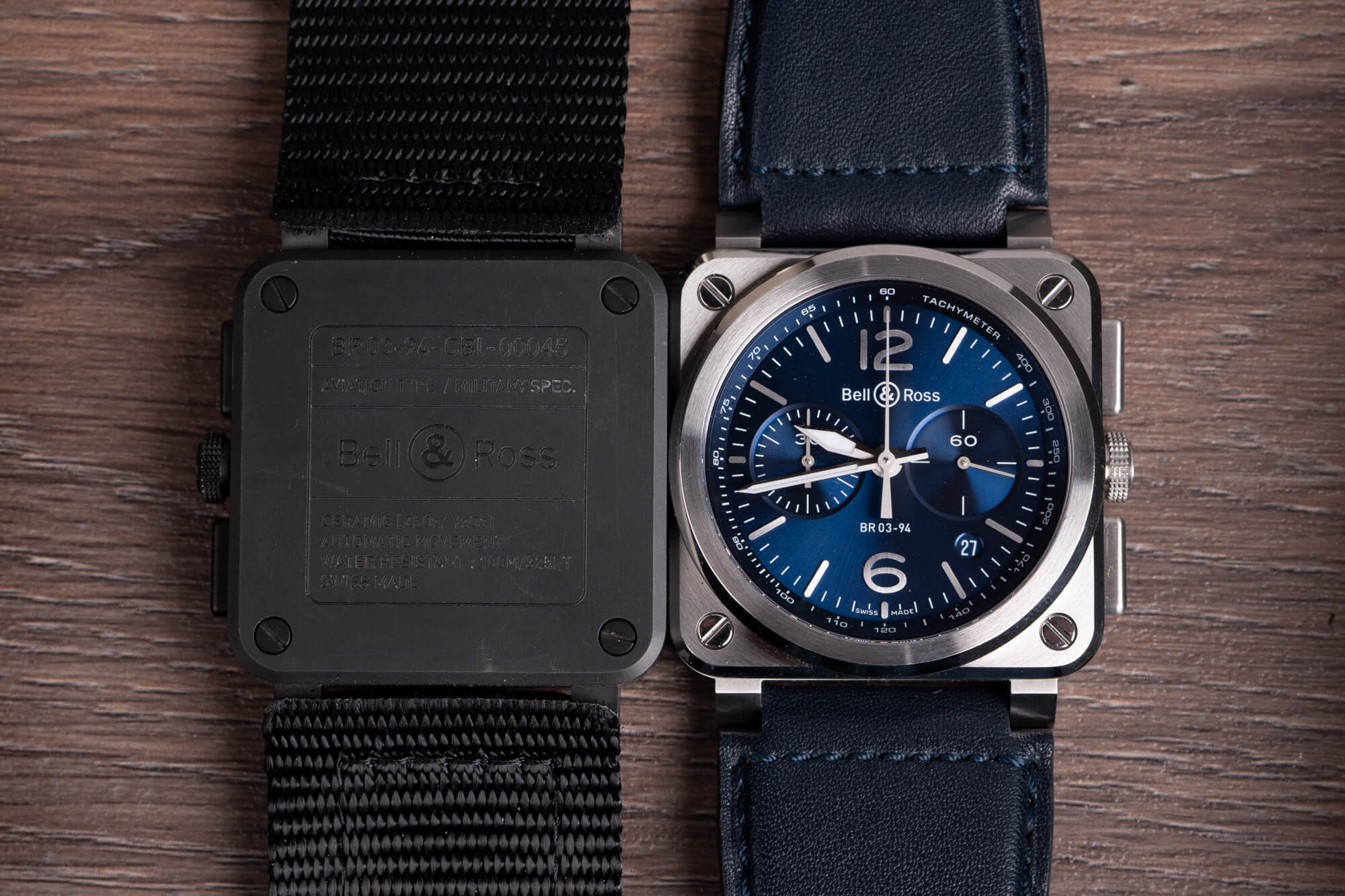 The BR 03-94s feature solid casebacks with military-like text and screws that connect to the dial-side bolts. They house the BR-CAL.301 automatic chronograph movement. This is simply a rebranded ETA 2894-2 with a 42-hour power reserve at 28,800 vph. This caliber is widely used across the industry and for good reason. I found the chronograph operation to be smooth and found no issues with timekeeping. While it’s not clear what grade the brand uses, but I tracked this watch at +10s per day across the three weeks, under the ETA 2894-2 standard grades quoted -/+12 seconds per day.
The BR 03-94s feature solid casebacks with military-like text and screws that connect to the dial-side bolts. They house the BR-CAL.301 automatic chronograph movement. This is simply a rebranded ETA 2894-2 with a 42-hour power reserve at 28,800 vph. This caliber is widely used across the industry and for good reason. I found the chronograph operation to be smooth and found no issues with timekeeping. While it’s not clear what grade the brand uses, but I tracked this watch at +10s per day across the three weeks, under the ETA 2894-2 standard grades quoted -/+12 seconds per day.
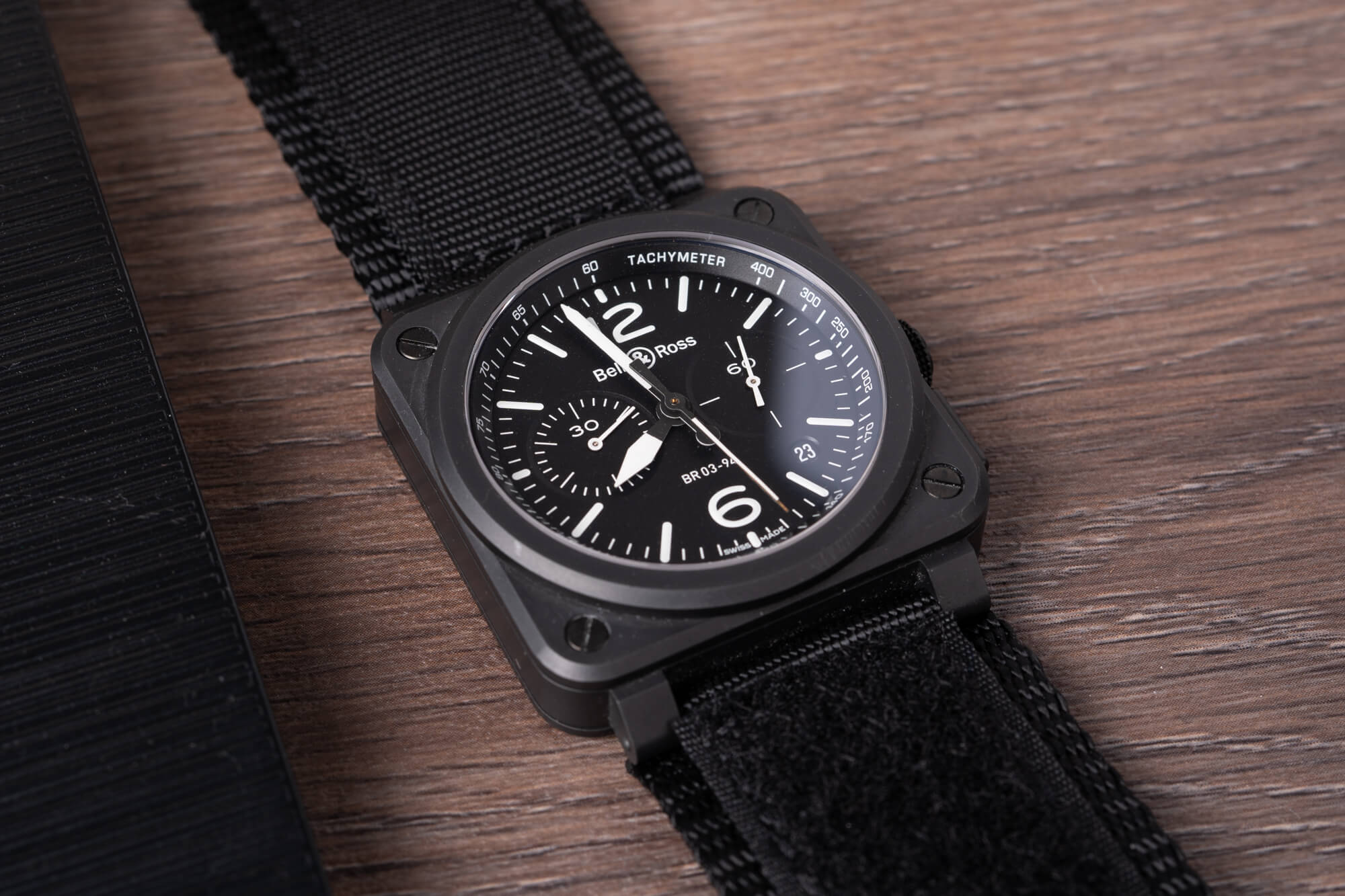 These two chronographs are about as simple as it gets if you want Bell & Ross’s signature cockpit instrument look. For those interested in a dyed-in-the-wool aviation-inspired chrono, you may not be able to do better than the black ceramic BR 03-94. On the other hand, if you’re a fan of the overall square watch style, but either don’t love a black watch or the starkness of that one’s dial, the steel and blue version offers something a bit less serious, yet more polished. The Bell & Ross BR 03-94 in steel is priced at $5,400 USD, while the black ceramic is priced at $5,500 USD. For more information, please visit the brand’s website.
These two chronographs are about as simple as it gets if you want Bell & Ross’s signature cockpit instrument look. For those interested in a dyed-in-the-wool aviation-inspired chrono, you may not be able to do better than the black ceramic BR 03-94. On the other hand, if you’re a fan of the overall square watch style, but either don’t love a black watch or the starkness of that one’s dial, the steel and blue version offers something a bit less serious, yet more polished. The Bell & Ross BR 03-94 in steel is priced at $5,400 USD, while the black ceramic is priced at $5,500 USD. For more information, please visit the brand’s website.
Necessary Data
>Brand: Bell & Ross
>Model: BR 03-94 Chronograph
>Price: $5,200+ USD
>Size: 42mm diameter, 12.8mm thick, 51.5mm lug-to-lug, 24mm lug width
>When reviewer would personally wear it: Casual weekend outing to the Air and Space Museum or playing any flight sim
>Friend we’d recommend it to first: Aviation enthusiast
>Best characteristic of watch: Neato cool cockpit dial design, surprising wearability
>Worst characteristic of watch: Poor lume, divisive case design, and reliance on B&R straps for wearability

